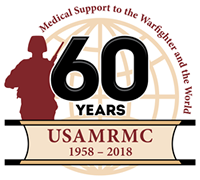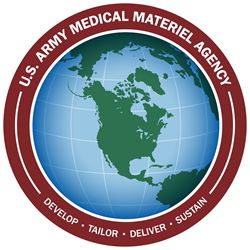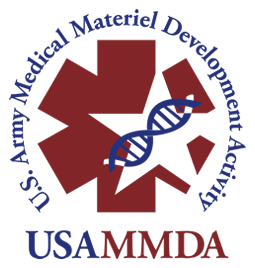Forging Ahead in Medical Product Development
The U.S. Army Medical Research and Materiel Command realigned major functions of two subordinate commands, the U.S. Army Medical Materiel Development Activity and the U.S. Army Medical Materiel Agency, July 9, at Fort Detrick, Maryland.
Approved earlier this year by USAMRMC and Fort Detrick Commander Maj. Gen. Barbara R. Holcomb, the change reallocates materiel development, initial procurement, assemblage management and sustainment functions between USAMMDA and USAMMA to improve the effectiveness and efficiency of the USAMRMC's lifecycle enterprise.
Tasked with developing and delivering quality medical capabilities to protect, treat and sustain the health of Service Members worldwide, USAMMDA's team of military, civilian and contractor personnel manage the Army acquisition process to ensure the expedited conveyance of critical medical products and devices requested by our nation's Warfighters. In conjunction, the team at USAMMA works to tailor, deliver and sustain medical materiel capabilities and data in order to build and enable health readiness, and its workforce focuses on equipping and sustaining our nation's military medical force.
Col. Ryan Bailey, USAMMDA commander, believes the realignment will help to increase mission effectiveness for both organizations.
"Essentially, within the USAMRMC, we had two commands [USAMMDA and USAMMA] focused on the development of products to meet Warfighter needs," he said. "Over time, both teams began managing products that created a potential for duplicative efforts – which is not an optimal structure with regard to efficiency or economy."
Bailey explained that USAMRMC leadership conducted a thorough analysis to review the products and processes of both organizations, to determine the best way to manage acquisition and medical product development going forward. The results of this examination were clear, and it was decided that the developmental components at USAMMA would be transitioned to USAMMDA, while all aspects of assemblage management would be moved from USAMMDA to USAMMA.
"We are utilizing the strengths of each organization – product development for USAMMDA and management/modernization for USAMMA – and shifting the responsibilities for more effective alignment," said Bailey. "This new structure will truly optimize the talents of both groups, which will directly benefit our Service Members."
Leadership from both groups expects this structural change will help to improve their respective processes, allowing products to move more quickly through the Army acquisition pipeline while also creating a more effective application of their scarce resources and funds.
"This is a very exciting change for both teams," said Kathleen Berst, deputy to the commander for acquisition, USAMMDA. "By refining USAMMA's and USAMMDA's missions by aligning functions to organizational competencies, it strengthens the USAMRMC lifecycle command."
Dr. Tyler Bennett, deputy to the commander for acquisition, USAMMA, holds a similar view of this transition.
"Change can be difficult, but the teams have really leveraged the realignment as a positive opportunity to streamline and clarify organizational functions," said Bennett. "Any time that we can find ways to be more efficient and effective, we must explore them with an open mind and be willing to make changes that result in a better organization."The realignment of forces has prompted a change in the structure of USAMMDA's four Project Management Offices. While the organization's Pharmaceutical Systems PMO will continue as before, its three other offices are being updated slightly to accommodate the new personnel and medical products entering from USAMMA. As the former Tissue Injury and Rehabilitative Medicine PMO has been integrated with the non-brain health portions of USAMMA's Medical Devices Advanced Development PMO, it is now named Combat Trauma and Acute Rehabilitation, and the Neurotrauma and Psychological Health PMO will now have a more robust portfolio due to the new brain health products brought over from the Medical Devices Advanced Development PMO. In addition, the Medical Support Systems PMO has added Evacuation to its moniker to encompass the medical evacuation programs that are being transitioned to the USAMMDA portfolio. Within USAMMA, while the Medical Devices Advanced Development and Medical Evacuation PMOs have transitioned to USAMMDA, the remaining PMO structure has changed slightly. The organization maintains its Medical Device Modernization and Integrated Clinical Systems PMOs as current; however, its Medical Devices Assemblage Management PMO will supervise existing assemblage management activities while it gains the responsibility of overseeing all sets, kits and outfits brought over from the USAMMDA portfolio.

PROJECT MANAGEMENT OFFICE
REALIGNMENT

Medical Devices – Assemblage Management PMO
Manages the authorized non-expendable, durable, and expendable components required within the Class VIII unit assemblages throughout their lifecycle to ensure the Warfighter has the necessary equipment and materiel to meet their assigned mission-essential tasks.Medical Device – Modernization PMO
Acquires and fields modernized medical capabilities that maximize Warfighter Readiness, leveraging lessons learned from previous conflicts to provide sustainable medical materiel solutions for the 21st Century.Integrated Clinical Systems PMO
Executes a patient-centric approach to ensure the timely delivery of affordable, sustainable, interoperable, and information assurance-compliant capabilities for institutional medical treatment facilities.
Pharmaceutical Systems PMO
Develops and delivers vaccines, drugs, diagnostics, and hemorrhage control and resuscitation products to protect, treat, and sustain the health of our U.S. Service Members.Medical Support Systems and Evacuation PMO
Designs, develops, procures, tests and sustains the best medical evacuation, combat casualty care support, and operational and preventive medicine solutions for the Combat Soldier.Neurotrauma and Psychological Health PMO
Rapidly develops and fields U.S. Food and Drug Administration-approved medical solutions across the continuum of care that aid in the detection, protection, prevention and treatment of neurotrauma and psychological health conditions, such as Traumatic Brain Injury (TBI), Post-Traumatic Stress Disorder (PTSD), and suicide.Combat Trauma and Acute Rehabilitation PMO
Fields U.S. Food and Drug Administration-cleared or approved medical devices, drugs, and biologics that fulfill the unmet requirements identified by the Service end user.Bailey says all of these modifications are intended to create a structure for success. "We closely reviewed the portfolios transitioning from USAMMA, to ensure that their efforts were synchronized with ours right from the start," he explained. "During this review, we decided that our Medical Support Systems group would align well with USAMMA's Medical Evacuation team; and we also formed the Combat Trauma and Acute Rehabilitation PMO by combining our TIRM PMO with USAMMA's efforts related to its Medical Devices team – and we're very excited about the future prospects of these newly combined groups."
"But we're also looking at all of our products across the board, to make sure each one is correctly aligned under the respective PMO," continued Bailey. "We still may realign some of these products if necessary."
Col. Lynn Marm, USAMMA commander, believes this reallocation of both personnel and responsibilities will greatly benefit all involved.
"The realignment is a very positive change for the entire organization because it allows us to capitalize on the inherent strengths of our teams and their valued roles within the USAMRMC enterprise," said Marm. "The realignment also provides much needed clarity to both internal and external stakeholders on each organization's mission space."
Bailey stressed that everyone involved has put a great deal of effort into ensuring this transition will be as smooth as possible.
"We're committed to setting up everyone for success, including both new and current USAMMDA team members," he said. "Our focus, now and always, remains on delivering solutions to our Warfighters quickly – and this transition is really about carrying out our mission better and more efficiently."













